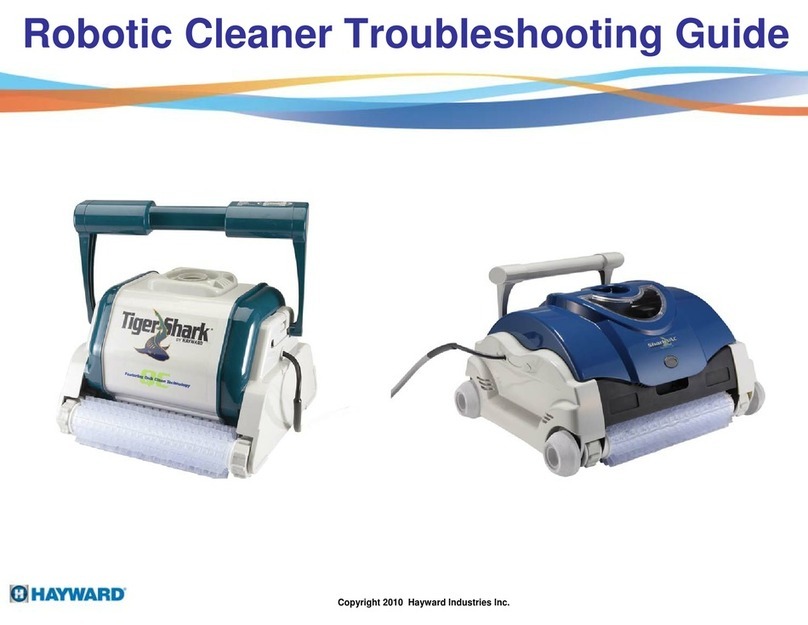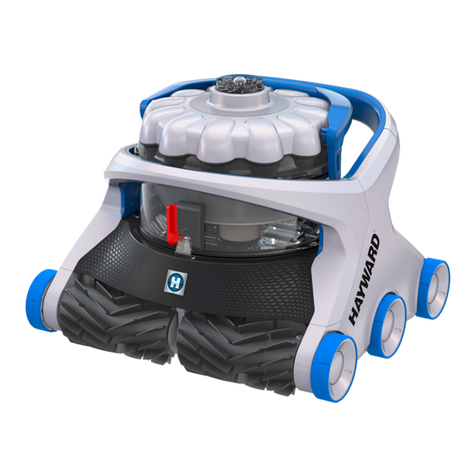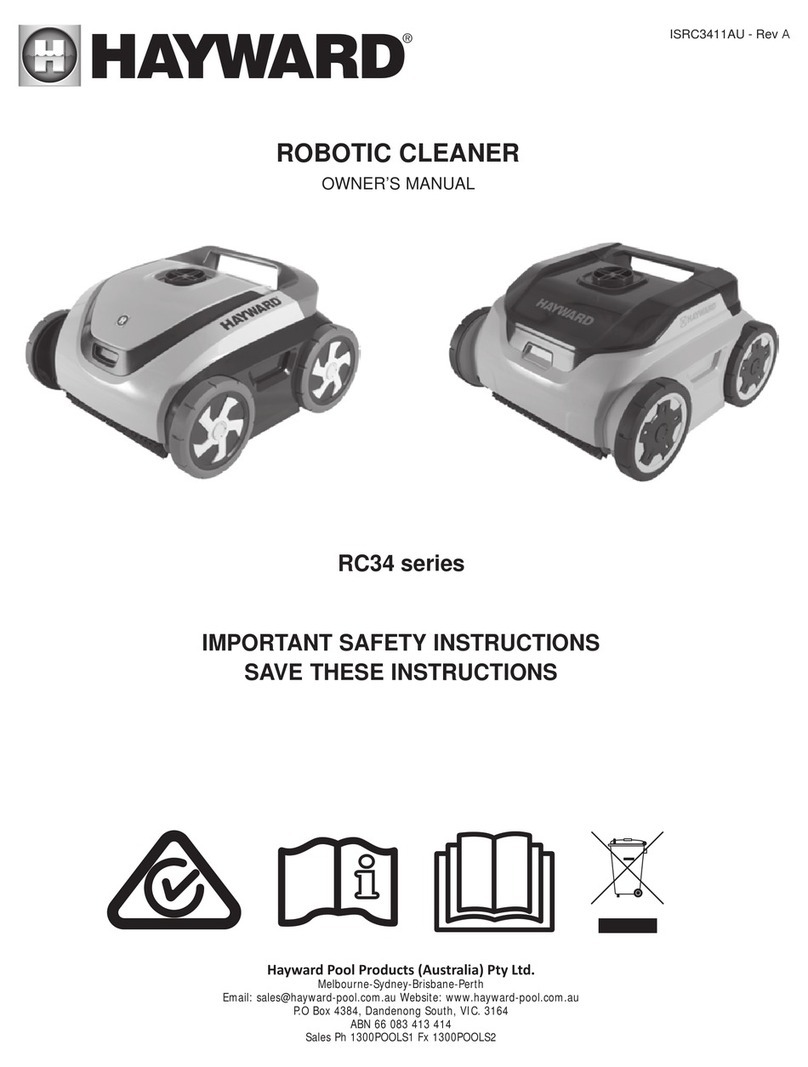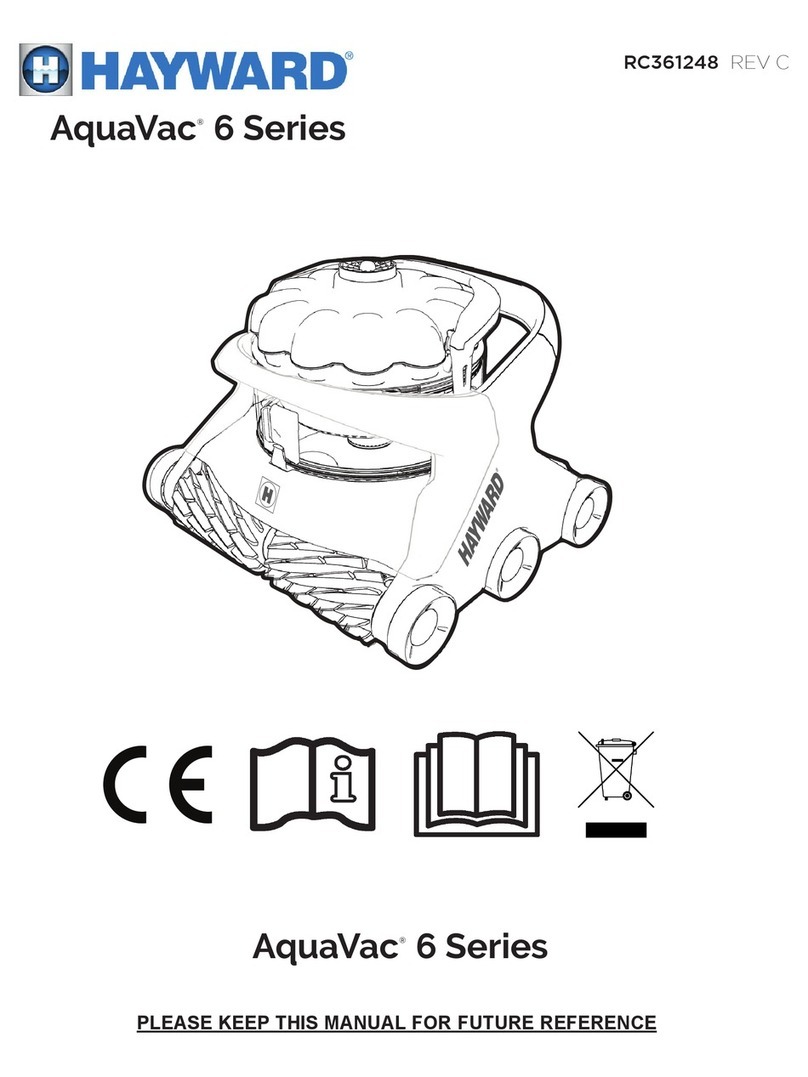Hayward Aquashark Series User manual

+
www.hayward-pool.com
Hayward Pool Products
620 Division Street
Elizabeth, NJ 07207
www.hayward.com
Hayward Pool Europe
1070 Allée des Chênes
01150 St-Vulbas, France
www.hayward.fr
Hayward Pool Products (Australia) Pty Ltd.
Melbourne-Sydney-Brisbane-Perth
P.O Box 4384, Dandenong South VIC. 3164
www.hayward-pool.com.au
Hayward Pool Products Canada
2880 Plymouth Drive
Oakville, ON L6H 5R4
www.haywardpool.ca
»»» Robotic Cleaner
Aquashark®Series
PART #R-QRG0990

IMPORTANT SAFETY INSTRUCTIONS
SAVE THESE INSTRUCTIONS
When installing and using this electrical equipment, basic safety precautions should always be
observed including the following. Failure to adhere to the safety warnings below may result in
severe injury, death or property damage.
• Closely supervise children and pets at all times to ensure
they do not play with the cleaner – it is not a toy.
• Ensure that children do not attempt to access the cleaner
while it is operating.
• This appliance is not intended for use by persons with
reduced physical, sensory or mental capabilities, or lack of
experience and knowledge, unless they have been given
supervision or instruction concerning use of the appliance by
a person responsible for their safety.
DO NOT PERMIT CHILDREN TO USE THIS PRODUCT.
• NEVER swim with the cleaner in the pool.
• Always disconnect and completely remove the cleaner
before entering the pool.
• All electrical wiring MUST be in conformance with applicable
local codes and regulations (See table at end of document).
Always follow local code requirements. Hazardous voltage
can shock, burn, and cause death or serious property damage.
• The cleaner should only be used with the provided cleaner
control unit, which supplies only Safety Extra Level Low
Voltage (SELLV) to the cleaner.
• The cleaner control unit shall be located at least 3.5 m (11.5 ft.)
from the closest edge of the pool.
• To reduce the risk of electric shock, DO NOT USE AN
EXTENSION CORD to connect control unit to electrical
outlet. This could create a safety hazard and/or damage
to the cleaner. Provide a properly located electrical outlet
per local building codes.
This is the safety-alert symbol. When you see this symbol on your equipment or in this manual, look
for one of the following signal words and be alert to the potential for personal injury.
WARNING warns about hazards that could cause serious personal injury, death or major
property damage and, if ignored, presents a potential hazard.
CAUTION warns about hazards that will or can cause minor or moderate personal injury
and/or property damage and, if ignored, presents a potential hazard. It also makes consumers
aware of actions that are unpredictable and unsafe.
READ AND FOLLOW ALL INSTRUCTIONS
WARNING - RISK OF INJURY
WARNING - RISK OF ELECTRICAL SHOCK
WARNING - RISK OF ELECTRICAL SHOCK
• Disconnect the cleaner control unit from the electrical
outlet before carrying out any user maintenance. Before
working on any equipment, disconnect control unit
from the equipment.
• Do not bury cable. Do not operate the cleaner with a
damaged cable. If the control unit power cord is damaged,
it must be replaced by the manufacturer, service agent, or
similarly qualied persons in order to avoid a hazard.
• In the United States and Canada, the cleaner control unit
must be connected only to a supply circuit protected by a
ground-fault circuit-interrupter (GFCI). Contact a qualied
electrician if you cannot verify that the circuit is protected
by a GFCI. This GFCI should be tested on a routine basis.
To test the GFCI, push the test button. The GFCI should
interrupt power. Push reset button. Power should be
restored. If the GFCI fails to operate in this manner, the
GFCI is defective. If the GFCI interrupts power to the
cleaner control unit without the test button being pushed,
a ground current is owing, indicating the possibility of
an electrical shock. Do not use the cleaner control unit.
Disconnect the cleaner control unit and contact the
manufacturer for assistance.
• In Europe, Australia and New Zealand, the cleaner control
unit must be supplied through a residual current device
(RCD) having a rated residual operating current not
exceeding 30 mA. Contact a qualied electrician if you
cannot verify that the circuit is protected by a RCD.
• Never allow the plug to enter the water.

OPERATION INSTRUCTIONS AND
IMPORTANT INFORMATION
READ BEFORE USING THE CLEANER OPERATING CONDITIONS
CAUTION - RISK OF EQUIPMENT DAMAGE
• Do not operate outside the pool. This will damage the motor
seal and void the warranty.
• Do not drag the cleaner out of the pool against the side wall.
This could damage the cleaner and/or the pool wall.
• Only operate the cleaner for the period of time necessary to
clean the pool. Excessive use is unnecessary and will cause
cleaner parts to prematurely wear.
• Regularly inspect the cleaner, cables and control unit. Do
not use if damaged or if any rough edges are visible on the
cleaner. This can cause damage to the pool.
• Cleaner lter cartridges or debris canister should be
thoroughly cleaned after each use or as often as needed to
ensure the cleaner’s optimal performance.
• Never store the cleaner with dirty lter cartridges
or debris canister.
• Water temperature operation range: min 50°F / 10°C,
max 95°F / 35°C. Maximum operating depth: 3 m (10 ft.)
• Operating the cleaner in temperatures above or below this
range may affect performance, and cause premature
wear or failure.
• Ambient air temperature: max 104°F / 40°C.
• To protect from permanent damage, if the cleaner is exposed
to extremely hot ambient temperature, the power-supply will
limit or suspend operation until its temperature is down to an
acceptable operating level. To limit overheating and reduced
performance, it is recommended to keep the control unit out
of direct sunlight and keep the cooling fan unobstructed.
BOX CONTENTS
UNPACKING
• Operation instructions and warranty pack with product
information (serial and model number)
• Accessory pack
• Cleaner with cable
• Control unit
• Carefully remove the contents of the box from the top.
Do not put the box on its side to remove content as some
parts may fall out of the box and get damaged.
• Verify the contents of the box.
• Carefully read the operation instructions and warning
document rst.
Unpacking and Cleaner Preparation

CAUTION - RISK OF EQUIPMENT DAMAGE
3. Check the water chemistry. The water should be
properly balanced (pH level), and the pool free from
algae. Algae can adversely affect the operation and
performance of the cleaner.
4. Clean or backwash the ltration system without the
cleaner in the pool.
The cleaner is not intended to clean the pool after extended
periods of disuse until the following steps have been taken:
1. Clear the pool of any large objects that might interfere
with the cleaner’s operation.
2. Check to see that the water is at the recommended level.
NEW POOL CONSTRUCTION
POOL PREPARATION
POOLS WITH EXCESSIVE DEBRIS
• The cleaner should not be used to remove plaster dust or
construction debris from new or renovated pools.
• Brush the newly constructed pool surface and vacuum new
surface debris before installing the cleaner.
• The cleaner should not be used to remove excessive debris
before a seasonal pool opening or following a high wind
event or sandstorm.
• Pools with excessive amounts of debris should be
vacuumed manually before using the cleaner.
• Always empty the cleaner lter cartridges or debris canister
when lled with debris.
Pool Preparation
• NEVER SWIM WITH THE CLEANER IN THE POOL.
• Before using the cleaner, remove any items such as
thermometers, toys and other accessories from the pool.
Such items may cause damage to the cleaner or the pool.
Large debris should also be removed manually from
the pool before installing the cleaner.
• Chemical balance of water may affect cleaner performance,
accelerate wear of certain parts, and may lead to more
frequent maintenance.
• DO NOT LEAVE THE CLEANER IN THE POOL WHEN
CHEMICAL SHOCKING THE POOL.
• pH should be adjusted and kept between 7.2 – 7.8.
• Total chlorine should be maintained between 1.0 – 3.0 PPM.
The cleaner should never be used when chlorine level
(or other oxidizer) exceeds the normal values.
• Total alkalinity level should always be maintained
between 80 – 150 PPM.
• To keep the pool safe for swimming and protect your
equipment, have the water tested frequently and balance
chemicals accordingly.
pH: 7.2 - 7.8
Chlorine: 1.0-3.0 PPM
Total Alkalinity: 80 - 120 PPM
50˚- 100˚F
10˚- 37˚C
Cl2
>3.0 PPM

Control Unit Set-Up
Cleaner Set-Up
1. Sitting on a table or on the pool deck
2. Positioned on the caddy cart control unit cradle
Connect the cleaner cable to the control unit and plug the
control unit cord into a protected outlet.
To reduce the risk of electric shock, do NOT use an extension
cord to connect unit to electric supply.
INSTALL
The Aquashark Control Unit can be installed and
used in different locations:
To nd the best location for your control unit, please
consider the following:
• The control unit should preferably be kept in a shady area
and the cooling fan kept unobstructed.
• Leaving the control unit on the pool deck is acceptable but
precautions should be taken so it does not get damaged by
regular trafc around the pool or by playing children or pets.
• The cleaner control unit should be located at least
3.5 m (11.5 ft.) from the closest edge to the pool.
• To reduce the risk of electric shock, DO NOT USE AN
EXTENSION CORD to connect unit to electric supply.
• Based on your region of the world, the cleaner control unit
must be connected only to a supply circuit protected by a
ground-fault circuit-interrupter (GFCI) or a residual
current device (RCD).
240 V
50 Hz
GFCI
220/230 V
50 Hz
RCD
110/220 V
50Hz/60Hz

• It is ideal to have the control unit positioned near the
midpoint of your pool (lengthwise).
• Depending on the size and shape of your pool, the entire
length of the oating cable may not be necessary. The
oating cable should reach from the cleaner control unit to
the furthest point in the pool, plus the depth at the deep
end of the pool. To reduce cable tangling, any excess cable
should be coiled and placed next to the control unit.
• To minimize cord twisting, completely unroll and straighten
the cable before putting the cleaner the pool.
CLEANER LOCATION
POWER CABLE
>3.5m
Submerge the cleaner in the pool by gently rocking it back,
forth and sideways to help the cleaner purge trapped air and
sink to the pool bottom.
For units with foam rollers, squeeze the foam to allow the roller
to get soaked.

• During its cleaning cycle the cleaner may not climb the wall
or any vertical surfaces every time. It will adjust its cleaning
sequence to offer optimal pool coverage.
• For a faster (90 minutes) cleaning of the main pool area, the
Quick Clean mode can be selected (Available on Quick Clean
model only).
• It is normal for the cleaner to operate in both forward and
reverse directions.
CLEANING CYCLE
ON
QUIK CLEAN
FULL
CYCLE
~90 min.
~4 hrs.
~4 hrs.
~4 hrs.
REGULAR MODEL
QC MODEL
OFF
ON
ON
CLEANING CYCLE
The Aquashark has an adjustable handle. The handle must be
locked in a diagonal position in order to ensure optimal cleaning
results. The handle has two diagonal positions. Reverse handle
positions after each use to minimize cord twisting.
STARTING THE CLEANER

When the cleaning cycle is completed and the cleaner is either in
sleep mode (Start/Stop button light is solid blue) or in stand-by
mode (Start/Stop button light is blinking green), The Aquashark
Series can be easily removed from the pool by using the handle
on the cleaner.
1. Remove the cleaner by pulling it out of the water using the
handle on the cleaner.
2. Allow the cleaner to drain on the pool deck before removing
the lter cartridge for cleaning.
REMOVING THE CLEANER FROM THE POOL
30 s.
1. Place the Aquashark on its side.
2. Release the bottom lid latches and remove the bottom lid
assembly.
3. Pull out the filter cartridge. Your cartridge is a three piece
filter assembly that you may or may not remove the
elements for thorough cleaning.
4. Using a garden hose with a spray nozzle, pressure-wash the
filter elements to remove debris.
5. Wash the inside of the bottom lid.
6. Replace the filter cartridge into the Aquashark.
7. Install bottom lid and slide latches into lock position.
Filter cleaning solution can be used to remove D.E., excessive
dirt and/or sand.
Remember: The cleaner your lter is, the more efcient your
unit will perform.
CLEANING THE FILTER CARTRIDGE
CAUTION - RISK OF EQUIPMENT DAMAGE
Operating the cleaner with a full lter will result in reduced
performance, limited wall-climbing capability and limited debris
pick-up. Empty and clean the lter, when needed, to maintain
optimal performance. Heavier debris such as sand, pebbles and
rocks may require more frequent cleaning, since they have a
greater effect on the weight and buoyancy of the cleaner.

STORING THE CLEANER AND CADDY CART
THE FLOW RESTRICTOR
• When not in the pool, keep the cleaner away from direct
sunlight or store it in a protected area.
• For winter storage, store the cleaner in a place where it will
be protected from cold temperatures.
• Drain the cleaner completely before storage and remove all
remaining debris from the canister.
If the cleaner is climbing too high on the wall, the ow
restrictor may be installed to limit its climbing.

If Aquashark fails to pick up fine or heavy debris:
•Clean the lter. It may be clogged.
• Clip the high velocity inlet to the bottom lid. This inlet
creates extra suction for lifting ne or heavy debris. This
part also can be helpful if unit becomes routinely stuck
on a raised main drain.

Electric codes
Codes électriques
Códigos eléctricos
Codici elettrici
Vorschriften für die Elektroinstallation
Elektrische codes
Códigos elétricos
US: National Electric Code (NEC)
CAN: Canadian Electric Code (CEC)
AUS-NZ: AZ/NZS 3000
EU-UK
Use Only Genuine Hayward Replacement Parts
N’utilisez que des pièces détachées d’origine Hayward
Utilice únicamente piezas de repuesto originales de Hayward
Utilizzare esclusivamente pezzi di ricambio originali Hayward
Verwenden Sie nur Original-Ersatzteile von Hayward
Gebruik uitsluitend originele Hayward-onderdelen
Utilize apenas peças sobresselentes de origem Hayward
FNF EN C 15-100 GB BS7671:1992
DDIN VDE 0100-702 EW EVHS-HD 384-7-702
AÖVE 8001-4-702 HMSZ 2364-702:1994 / MSZ 10-533 1/1990
EUNE 20460-7-702 1993,
REBT ITC-BT-31 2002 MMSA HD 384-7-702.S2
IRL Wiring Rules + IS HD 384-7-702 PL PN-IEC 60364-7-702:1999
ICEI 64-8/7 CZ CSN 33 2000 7-702
LUX 384-7.702 S2 SK STN 33 2000-7-702
NL NEN 1010-7-702 SLO SIST HD 384-7-702.S2
PRSIUEE TR TS IEC 60364-7-702
Hayward Pool Products
620 Division Street
Elizabeth, NJ 07207
www.hayward.com
Hayward Pool Europe
1070 Allée des Chênes
01150 St-Vulbas, France
www.hayward.fr
Hayward Pool Products (Australia) Pty Ltd.
Melbourne-Sydney-Brisbane-Perth
P.O Box 4384, Dandenong South VIC. 3164
www.hayward-pool.com.au
Hayward Pool Products Canada
2880 Plymouth Drive
Oakville, ON L6H 5R4
www.haywardpool.ca
This manual suits for next models
1
Table of contents
Other Hayward Vacuum Cleaner manuals

Hayward
Hayward RC34 series User manual

Hayward
Hayward SharkVAC XL User manual

Hayward
Hayward AquaVac 6 Series User manual

Hayward
Hayward TigerShark User manual

Hayward
Hayward AquaVac 6 Series User manual

Hayward
Hayward AquaVac 500 User manual

Hayward
Hayward SharkVAC XL Pilot User manual

Hayward
Hayward TigerShark User manual

Hayward
Hayward RC34 series User manual

Hayward
Hayward RC361248 User manual

















